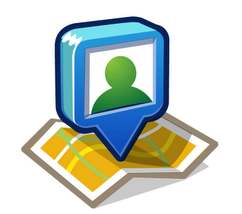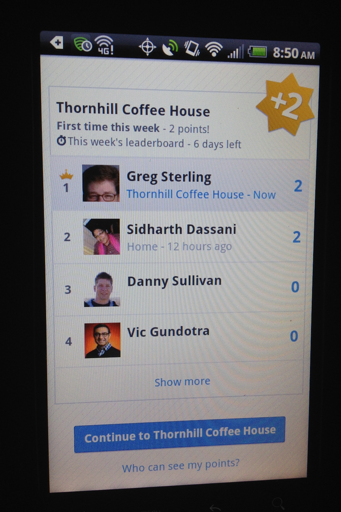Will Google Latitude Succeed As A Loyalty Platform?
While Google will tell you that Latitude has millions of users, what the company doesn’t generally talk about is how many of those people are actively engaged with the product. The consensus appears to be that Latitude is languishing. However Mountain View has been tweaking, enhancing and updating Latitude to breathe new life into it. […]
 While Google will tell you that Latitude has millions of users, what the company doesn’t generally talk about is how many of those people are actively engaged with the product. The consensus appears to be that Latitude is languishing. However Mountain View has been tweaking, enhancing and updating Latitude to breathe new life into it.
While Google will tell you that Latitude has millions of users, what the company doesn’t generally talk about is how many of those people are actively engaged with the product. The consensus appears to be that Latitude is languishing. However Mountain View has been tweaking, enhancing and updating Latitude to breathe new life into it.
A year ago Google added check-ins to Latitude. In April, 2011 Google added deals to Latitude. Then last week, as widely discussed, Latitude was given a check-ins leaderboard (Android only).
As part of that new leaderboard feature users are awarded points for check-ins at business locations. Those points are visible to other users on Latitude (if you’re connected to them) and “may be visible to other Google+ users, making it easier to find friends and play together.”

The Latitude leaderboard and related point system are being discussed in most articles as a direct challenge to Foursquare. However, Latitude has been adopting Foursquare-like features for some time. The irony is that Foursquare is moving in the opposite direction: adding more “utility” and moving away from reliance upon “gamification” to engage users.
The most interesting part of the new Google Latitude points/leaderboard system, from my point of view, is the way in which it supports loyalty marketing for local businesses. Here’s what the copy on the Google Maps for Mobile help site says about points and check-in status:
While viewing a Place page, you can see which status level you’ve achieved based on your check-in frequency. Your status starts as Visitor, and then progresses to Regular, VIP, and Guru in most places as you keep checking in (businesses may customize the names of status levels and icons).
To see your status level, look for the icon immediately below a location’s address on a Place page, accompanied by the text, “You’re a (visitor/Regular/VIP/Guru) here”. Touching your status level will bring you to the Recent check-in history page.
Keep checking in to achieve a new status level or maintain your existing one!
(emphasis added.)
True, status levels rolled out with the addition of deals last April. But points now permit user status to be tracked and managed more readily. If Google does all this right it will enable businesses to connect loyalty offers to certain status levels, driven by check-in points. That could make Latitude or Places into a valuable loyalty platform for local businesses or even national-locals.
One major caveat is that most small businesses are clueless about how to run effective loyalty marketing programs. Just as with self-service check-in Offers Google will need to provide guidance to enable local businesses to use these tools and capabilities effectively.
One significant and relatively obvious challenge is that Google has now got a dizzying array of local products and apps: Latitude, Maps, Places, Offers/Shopper and Google+ (for business owners). Android displays greater integration of these services than the iPhone, where each of these Google products are all essentially silos or separate apps.
I could argue they are all different “doorways” into the same or overlapping databases. But there’s a way in which it all feels too messy and even confusing.
Here’s another example: there’s a sense in some quarters that Google is de-emphasizing Google Places as a consumer destination on the PC but emphasizing Places in mobile. And what about Google+? There are people who believe that Google will merge Places and Google+ pages at some point in the near future. That’s no simple thing — unless Google simply converts all Places pages into Google+ profiles.
Back to Latitude, which is something of a “red-headed stepchild” in the Google local product family. One could argue that it should no longer be a separate “product” but instead a feature of other tools or services (it is in Google Maps for Android).
Stepping back, Google has now put some compelling pieces in place with this collection of apps and services around local and mobile. But Google will ultimately need to decide what it wants to emphasize as the primary entry point: Places, Google+ or Latitude. Indeed, with greater clarity and better execution Google can bring more value to its local apps for both consumers and business owners.
Related Entries
- Why Google Latitude’s Check In Deals Is A Few Degrees Off
- Google Finally Adds Check-Ins To Latitude, With A Couple Twists
- Google’s Check-in Offers To Be Self-Service Tool
Contributing authors are invited to create content for MarTech and are chosen for their expertise and contribution to the search community. Our contributors work under the oversight of the editorial staff and contributions are checked for quality and relevance to our readers. MarTech is owned by Semrush. Contributor was not asked to make any direct or indirect mentions of Semrush. The opinions they express are their own.
Related stories